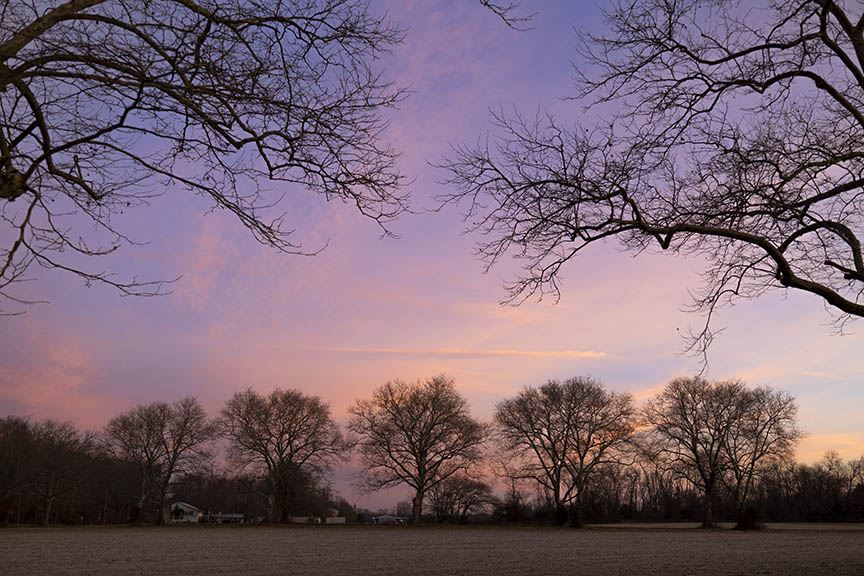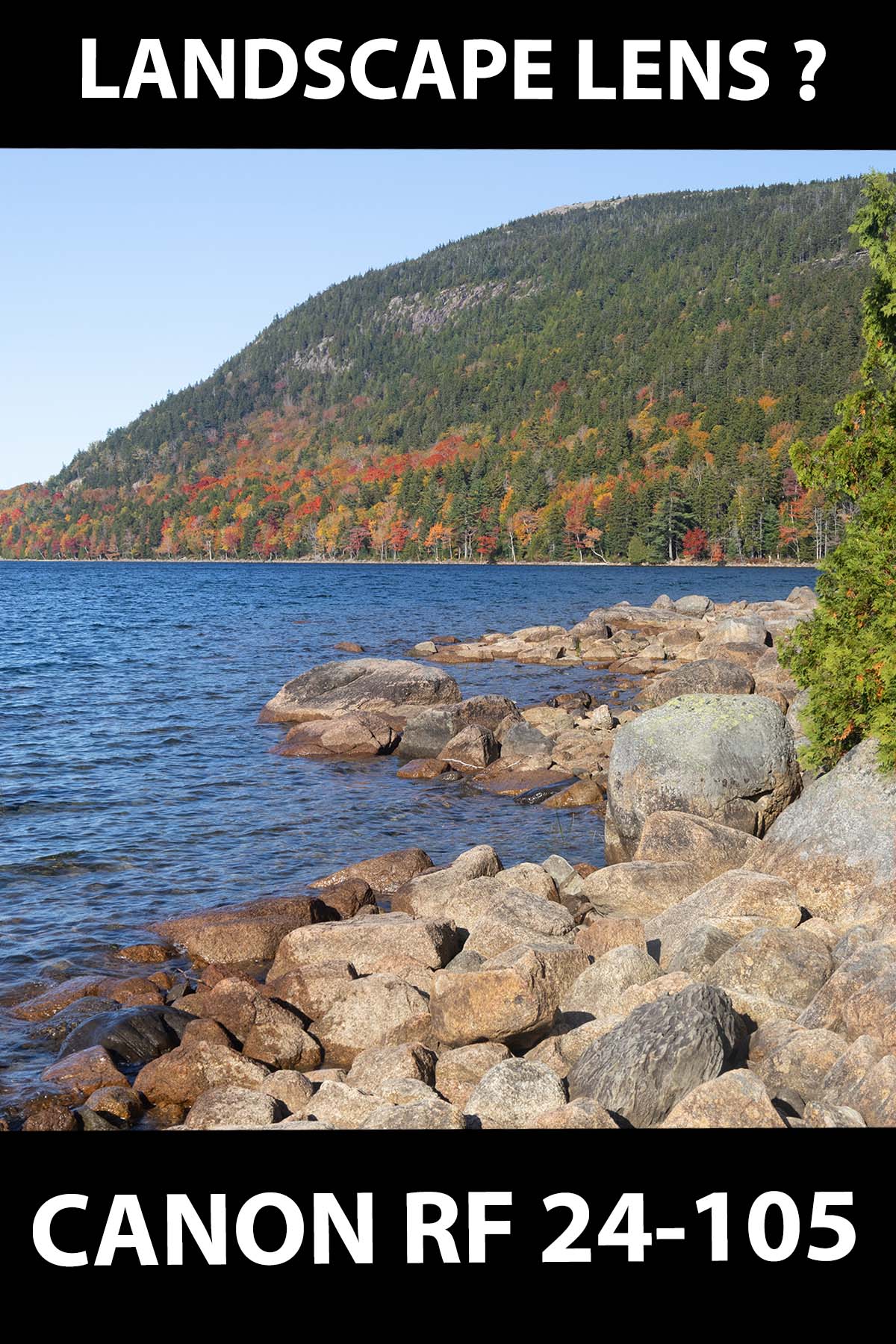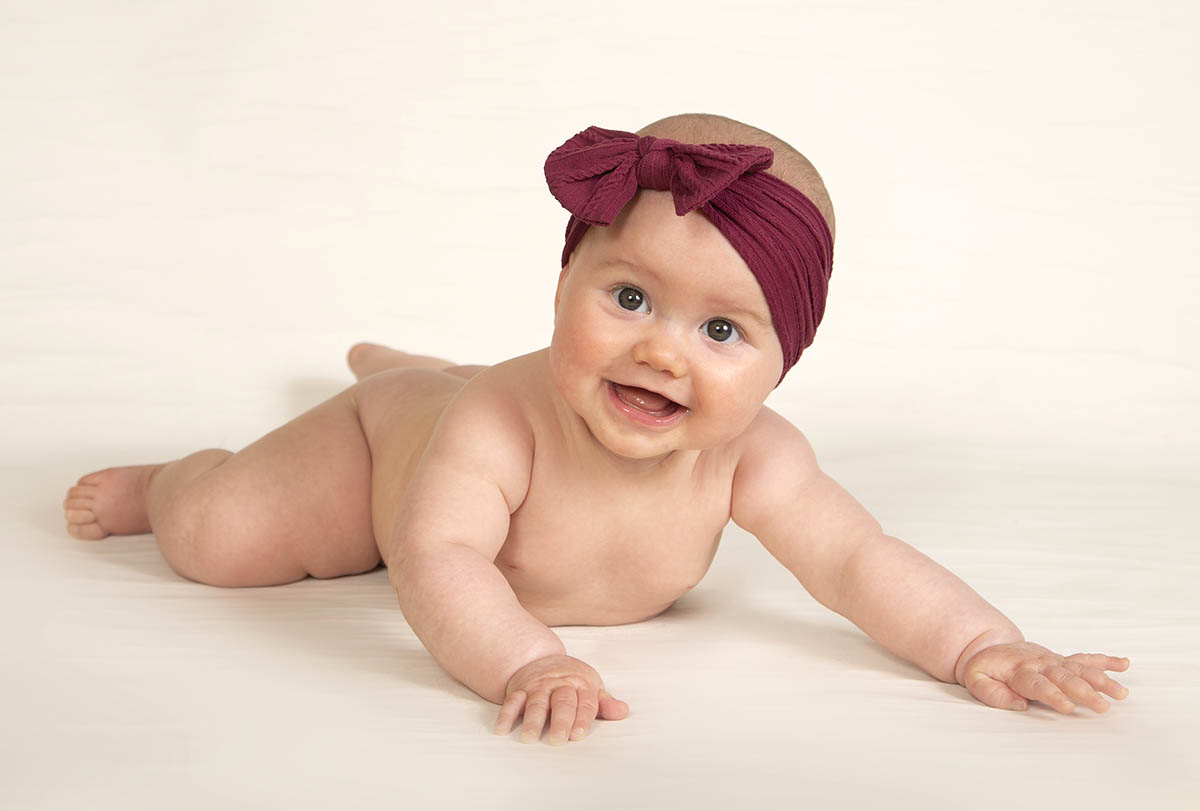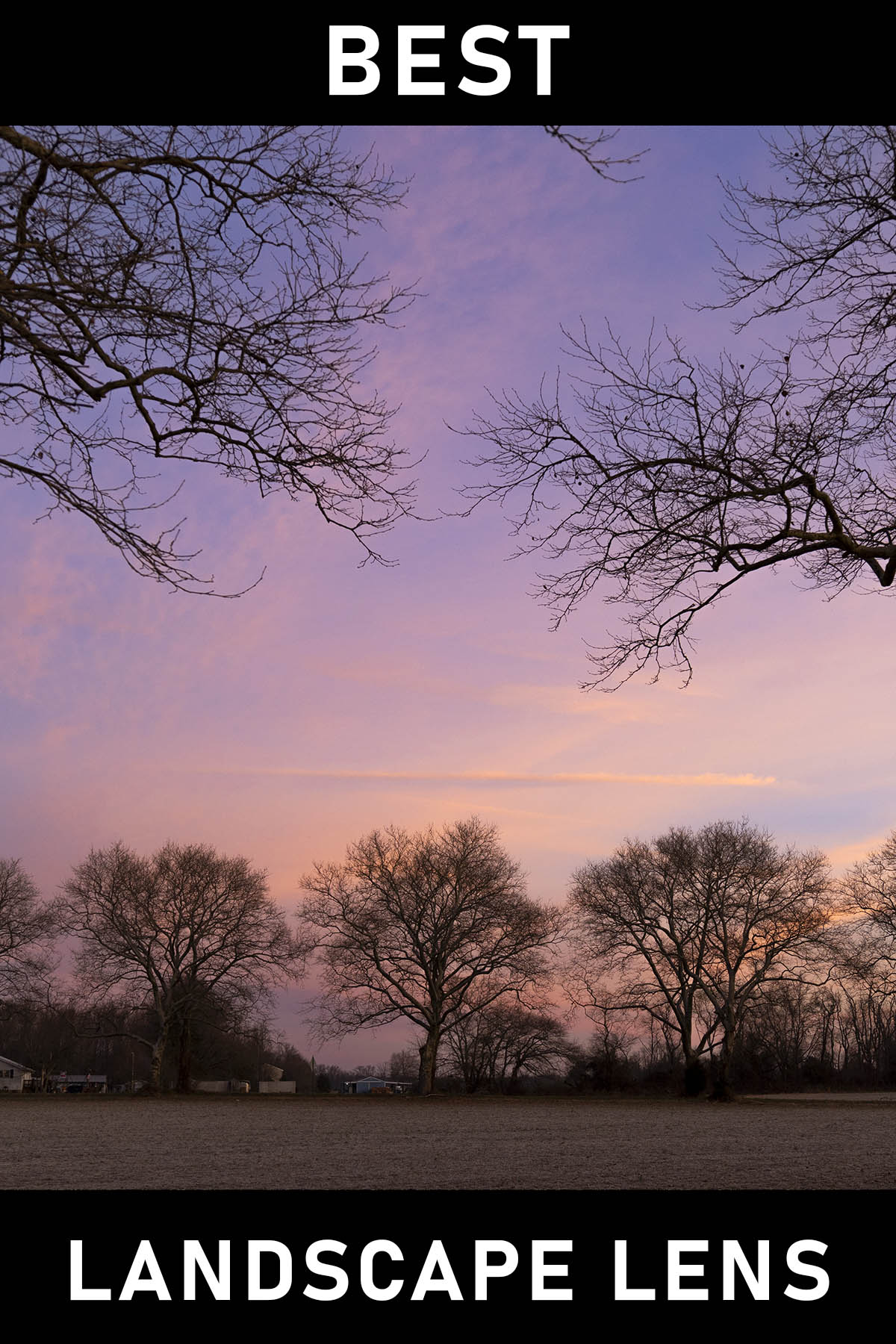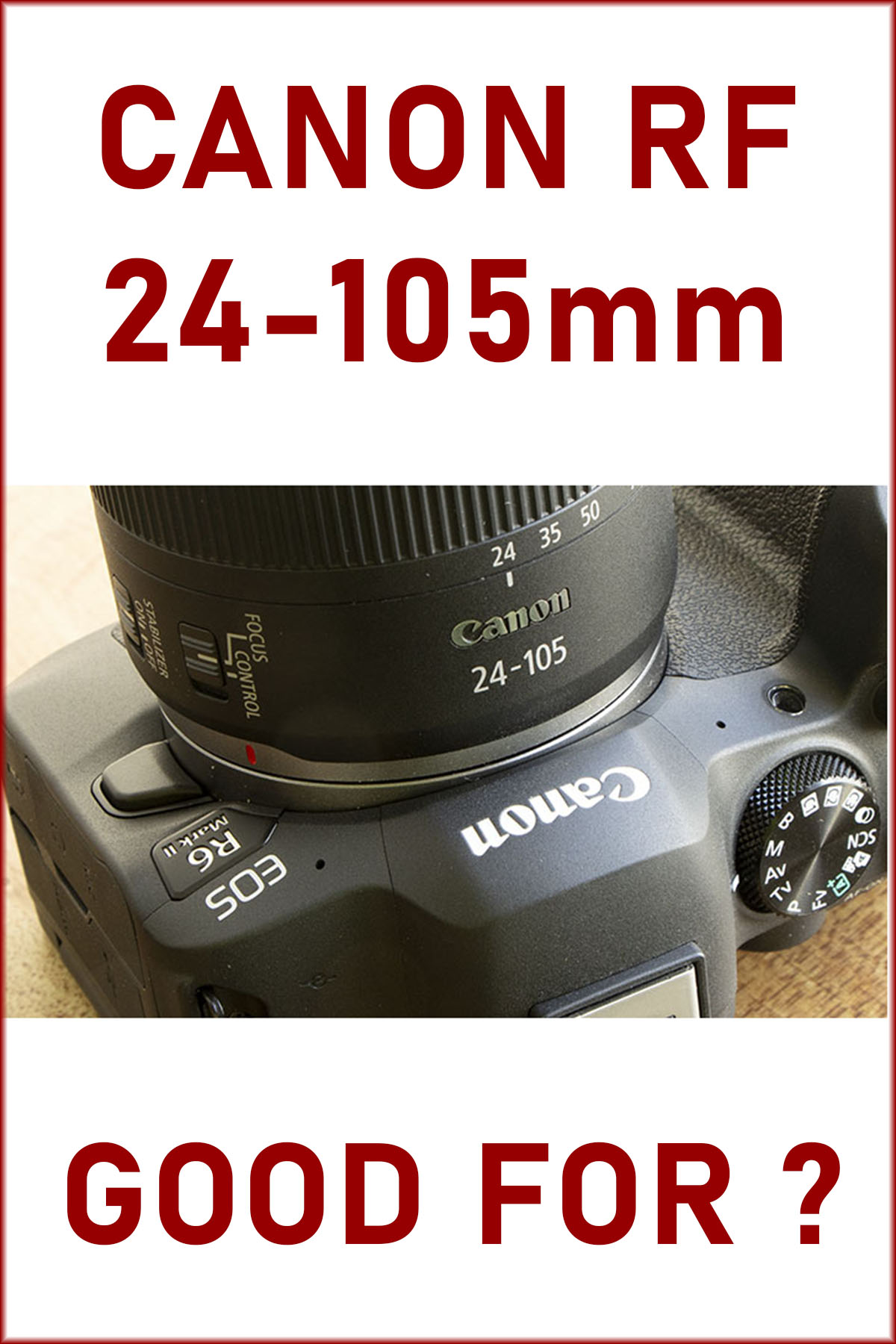What's the RF 24-105mm Lens Good For.
WRITTEN BY: BRUCE LOVELACE
UPDATED: October 23, 2024
There are three different version of the Canon RF 24-105 lens, but they all share one thing in common. They're great all-purpose lenses good for most kinds of photography.
This post explores specifically what the Canon RF 24-105mm lenses are good for shooting, as well as the weaknesses of each of them. Before we dive into the best ways to use a 24-105mm lens, watch this very short intro video on this lens:
RF 24-105 Compatibility
You may be wondering what cameras can you use with the RF 24-105mm lens.
The RF 24-105mm lenses work with all the Canon mirrorless "R" series cameras. That includes the Canon mirrorless APS-C crop camera bodies, like the R7 and R10, as well as all of the full frame camera bodies in the R lineup, including the R, the RP, the R3 R5, R6, R6 Mark II, and R8.
The RF 24-105mm lens is not compatible with the Canon mirrorless "M" series of Canon bodies, nor is it compatible with Canon's tradition DSLR (Digital Single Lens Reflex) cameras.
Here are eleven types of photography that are good for shooting with the RF 24-105mm f/4-7.1 STM lens.
1. Macro photography with the RF 24-105mm:
The RF 24-105mm lens is not a true macro lens, but you can still take stunning close-up photos with it just the same. The lens will shoot macro-like photos provided you use the right techniques with respect to lighting, composition, and focus.
I took the close-up photo of the model HO train railroad crossing sign below with my RF 24-105mm f/4-7.1 with the lens zoomed in to its maximum focal length of 105mm and the aperture set side open to f/7.1.
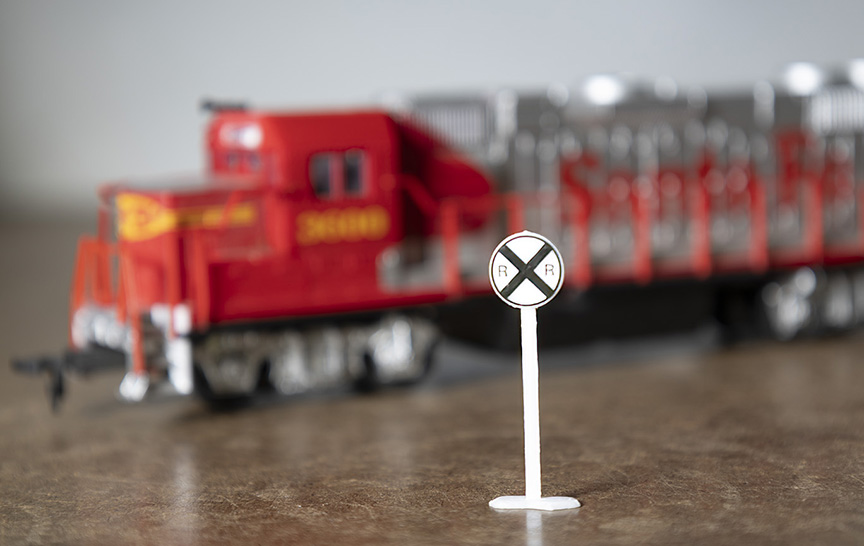 The RF 24-105 lens is good for shooting close-ups
The RF 24-105 lens is good for shooting close-upsThe RF 24-105mm f/4-7.1 achieves a maximum magnification of 0.5x and a minimum focusing distance of 5.1 inches when using the Center Focus Macro feature.
How To Get The MOST Out Of Your RF 24-105 lens for macro shooting
When you've attached this lens to one of Canon's high resolution mirrorless "R" series of cameras, you have plenty of pixels to crop your image even closer to get those super magnified images.
While not dedicated macro, this lens has a unique "Center Macro Focus" mode that allows for surprisingly creative close-up shots, where there is additional creative blur toward the edges that isolate your subject from the background.
For the ultimate macro lens in the "R" series, you should also take a look at the RF 100mm f/2.8 lens.
2. Travel photography with the RF 24-105mm
This lens's versatility and compact size make it a great choice for travel photographers. Not only is it easy to pack along on a trip, but you don't have to carry a 2nd lens to get those typical travel photos. The variety of shots you can capture with a lens that gives you a range of angles of view from 84° to 23°.
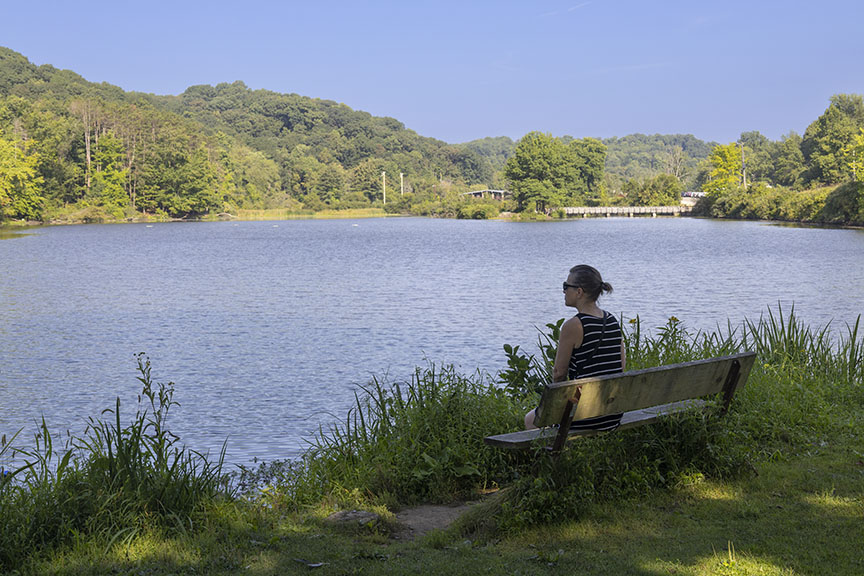 Scenic View near Pittsburgh, PA
Scenic View near Pittsburgh, PALens zoomed to 50mm
Using an RF lens-rather than an EF lens with one of the EF-EOS-R adapters-is a great way to lighten your load and save space when you're traveling.
The RF 24-105mm f/4-f/7.1 kit lens was the only lens I had when I traveled to Harpers Ferry, WV on a mini photo excursion. You can check out the variety of photos I took here.
3. Street photography with the RF 24-105mm
The f/4-7.1 version of the RF 24-105 is compact and easy to make less noticeable when using it to capture unsuspecting subjects in interesting photographic environments. The lens measures approximately just 3 inches by 3 1/2 inches.
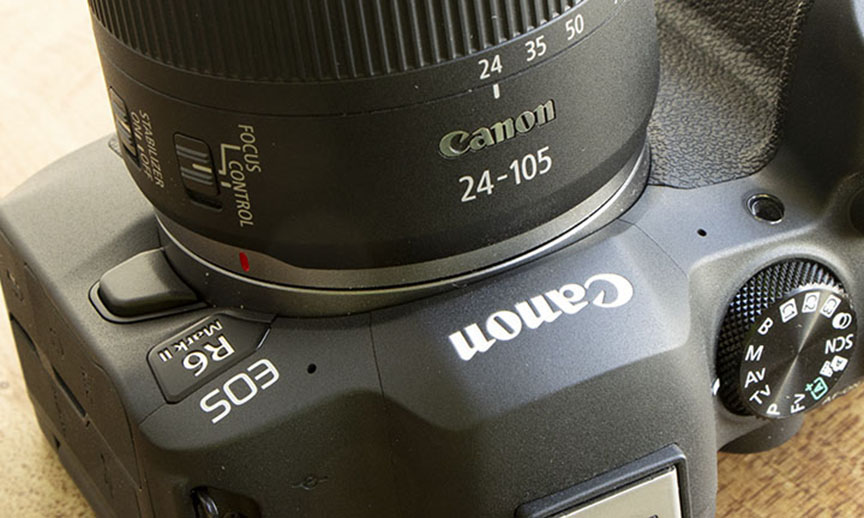 Canon RF 24-105mm f/4-7.1 STM lens mounted on Canon R6 Mark II
Canon RF 24-105mm f/4-7.1 STM lens mounted on Canon R6 Mark IIWhile not traditionally a street photography lens, the RF 24-105mm's range can be surprisingly useful for capturing candid moments on the go. Capture the entire environment by zooming out to 24mm or zoom in tighter to 100mm to isolate your subject from distracting elements in your composition.
4. Pet Photography
The RF 24-105mm lens is perfectly versatile for photographing pets. In the pet photo below, I used the 24-105 zoomed in fully to 105mm. This more distant vantage point gives you a nice "flat" perspective and is good for portraits of dogs, cats, and any other pet that you want to photograph.
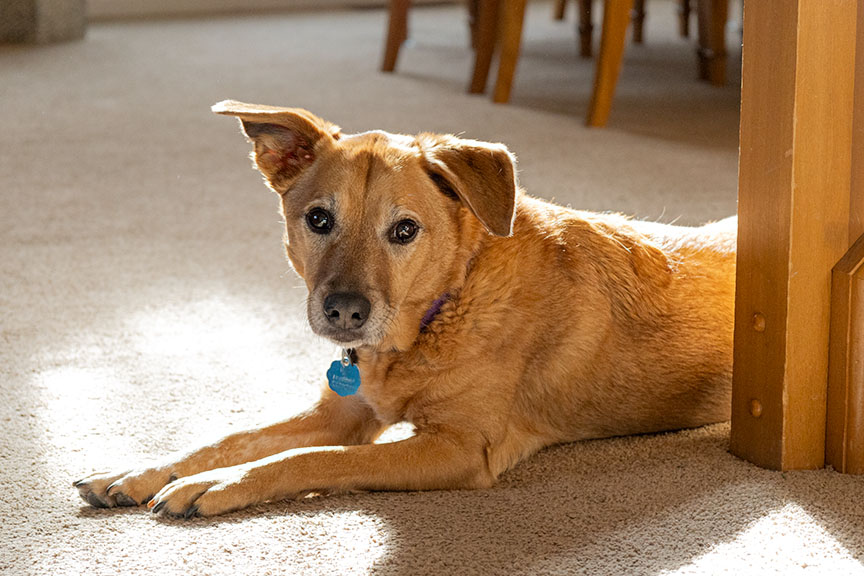 "Ruby" basking in the sun.
"Ruby" basking in the sun.Emphasize the subject by minimizing additional elements in the composition.
Lens zoomed to 105mm
I love the one ear up and one ear down look that "Ruby" gave me in the dog portrait above. She was a good color match with the carpeting staircase post, and wooden chair legs, too!
For pet photos with a stronger perspective zoom your lens out to a wider view, get in closer to emphasize your pets facial features.
5. Landscape Photography
The Canon RF 24-105mm f/4-7.1 STM lens is a good choice to take along when you're shooting landscape photography. It's my go to lens when I'm shooting with my R6 Mark II lens. If I carry a 2nd lens during a landscape photo excursion it's the EF 16-35mm lens along with an adapter.
As mentioned, the 24-105mm focal length is good for capturing landscape and nature photos. To shoot the typical landscape image, photographers often use the 24mm wide angle setting to include everything in the scene before them. At 105mm, you can narrow your view to photograph what's farther away.
In the photo below I zoomed to a mid focal length of 48mm to get the pleasing composition that included the rocks in the foreground, the pond at mid-distance, and the mountains in the far distance.
From sweeping mountainside vistas to close-up abstract detail shots like the ice patterns below, you can photograph the natural world and come away with breathtaking images.
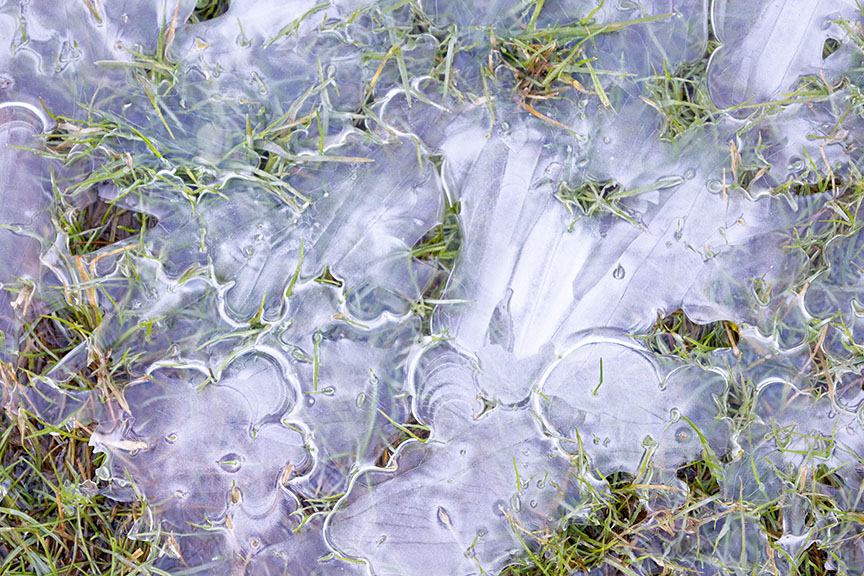 "Ice Patterns"
"Ice Patterns"Photographed at 105mm
In the photo above I wanted to capture the unique ice formation patterns that resulted from a puddle that formed in my back yard and a cold snap in the weather that immediately followed it.
6. Portrait Photography
The RF 24-105 lens is an outstanding portrait lens.
This is an important one for me as a portrait photographer. I used the EF 24-105 version of this lens with my 5D Mark III for shooting indoor portraits as well as sports teams outdoors for many years. Now I can use the RF version of the 24-105. It makes it easy to quickly switch back and forth between individual shots and group photos without having to change lenses.
With the exception of shooting business head shots indoors, the 24-105mm zoom lens is my go-to lens for photographing people. This lens can be used for group photos, full length individual posing as well as head shots.
7. Event Photography
The RF 24-105 is a great walk around lens for general coverage of any event.
Wedding and event photographers typically use one of the 24-105 or 24-70 f/2.8. I prefer the extra reach of the additional telephoto that the 24-105 gives you. Now that Canon has released the super-pricey, but remarkable RF 24-105 f/2.8, it's become the number 1 choice for pro photographers who can afford to invest in it.
I always used my 24-105 to shoot weddings, 1st holy communions, birthday parties, family reunions and other similar events where you want to be able to shoot close-up views of your subjects as well as group photos.
8. Documentary Photography
You can use the 24-105mm lens for documentary photography. It strikes a good balance between image versatility and quality, making it a solid choice for photography where you want to tell a story about something.
You can capture a wide variety of visual narratives through this lens. The 50mm focal length is often the go-to setting and that comes conveniently right in the middle of the zoom range that the 24-105 lens possesses.
9. Candid Photos
For candid photography, a wide-to-tele lens is the best workhorse to use. The 24-105mm focal length covers all those everyday candid snapshots that preserve those special memories to cherish for years to come.
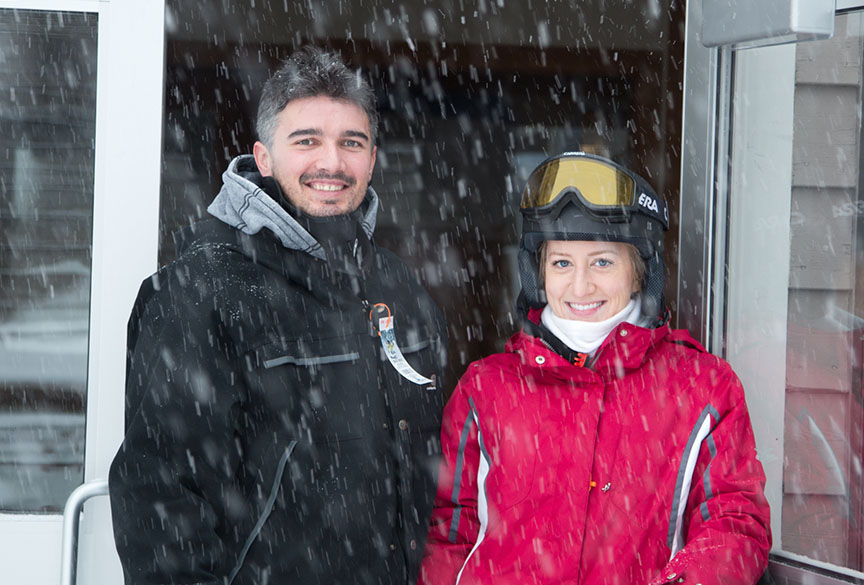 "Snowy Couple"
"Snowy Couple"Candid photo take at 67mm focal length
I zoomed in to 67mm to emphasize this couple as the main subject in the composition, but I still included enough of the environment to provide enough information to help tell a story.
10. Wildlife
It's not an ideal lens for it, but you can use this lens for wildlife photography.
Dedicated stronger telephoto lenses are usually suggested for photographing distant wildlife. In your back yard, the local park setting, or a zoo, you can have success. At 105mm focal length, you can capture images of animals and birds that are close by. You may have to crop in tighter with software afterwards to get a tighter shot when using this lens for wildlife.
11. Sports
The 24-105 lens can be used to shoot sports, but with the understanding that it has some limitations. The lens does have quick focusing for capturing quickly-moving subjects, but does not have a large lens opening to let enough light in dimly lit environments.
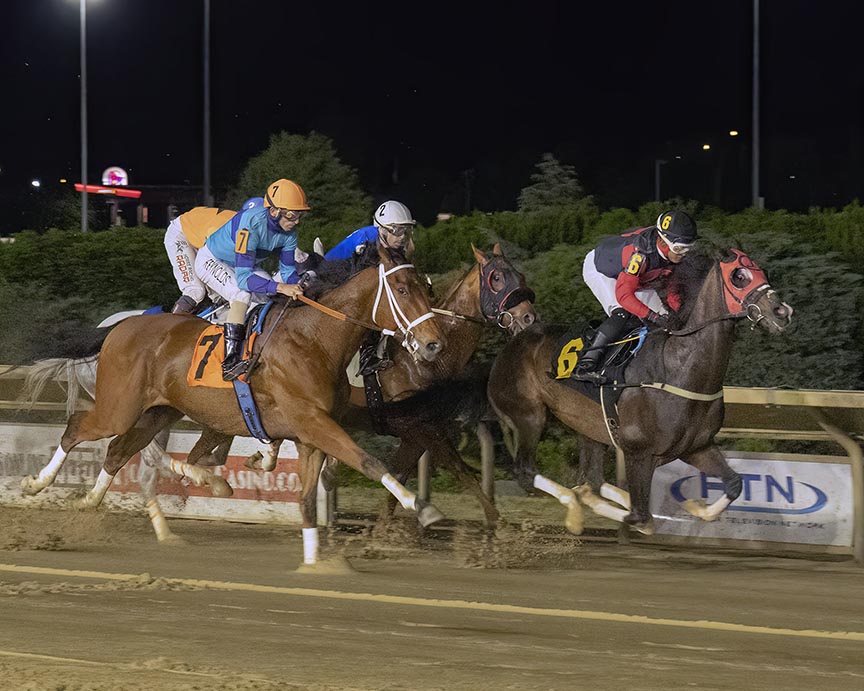 The RF 24-105 is great for sports if you combine it
The RF 24-105 is great for sports if you combine itwith a fast focusing, high ISO handling camera like the R6 Mark II
If you're near the action and you have sufficient lighting (outdoors or well-lit indoor environments), this lens is capable of getting some good action shots. It's not fast enough (large maximum apertures) to be labeled a sports lens, but if you're photographing your 6 year old playing soccer or T-Ball you'll make out fine.
Photographing indoor sports will likely require you to use high ISO settings to get fast enough shutter speeds to freeze the action.
RF 24-105 f/4-7.1 Advantages And Disadvantages
The lens is certainly versatile, but there is no such thing as a perfect lens. It's important to know its shortcomings along with the strengths of the RF 24-105mm f/4-7.1 lens.
Disadvantages
FOCAL LENGTHS: This lens has neither a ultra-wide nor a super long telephoto focal length. Serious landscape photographers may want even wider views than you get at 24mm on a full frame camera. Likewise, serious sports, bird and wildlife photographers prefer much longer zoom lenses for both distant and shy subjects.
VARIABLE MAXIMUM APERTURE: This 24-105 lens has a variable maximum lens opening as you zoom through its range. The lens opens to f/4 at 28mm, but can only open up to f/7.1 when it's zoomed into 105mm. This contributes to two issues when using the 24-105 f/4-7.1 lens.
First, not as much light can enter the camera when the maximum aperture is not great. Shooting in dimmer lighting is limited and faster shutter speeds are harder to achieve. Additionally you can't get as intentionally of a blurry background as you may sometimes want because of the smaller maximum aperture.
Advantages
VALUE: This extremely affordable lens is a great value for the money because of its well-rounded capabilities, the image quality it gives you, and its impressively small price tag.
SIZE: Despite being designed to fit on full size sensor cameras, the f/4-7.1 is light in weight, small is size, but still fully compatible with full-sized mirrorless camera bodies. It's easy to pack and easy to carry.
ZOOM RANGE: The 4.375 zoom range from wide to telephoto makes it a multipurpose lens, well-suited for a variety of photographic situations.
Alternative Lenses
- RF 24-240. If you like the lens at the wide angle end of its zoom range, but would like a little more reach, consider taking a look at the RF 24-240mm lens. although it's twice the price and close to twice as heavy and large, it also gives you twice the magnification on the telephoto end.
- RF-S 18-150. Consider the RF-S 18-150 f/3.5-6.3 as an alternative to the RF 24-105mm f/4-7.1 lens. It's even smaller and gives you the equivalent angle of view as a 38-240mm lens on a full frame camera in an even smaller and more affordable size. Remember though, it's an RF-S crop lens. so it has a magnification factor of 1.6x.
- VERSIONS 1 or 3. To compare the f/4-7.1 version of the lens to the other two, see my post on Canon RF 24-105mm lenses.
Summary
So, there you have it. The RF 24–105mm f/4-7.1 lens is indeed a jack of all trades lens, offering so much diversity and flexibility with the types of photos you can take. According to Canon, the RF version of this focal length lens is superior to the highly rated EF version in focusing speed and image quality.
Whether you're an experienced enthusiast or a beginner, this lens will spark your creative abilities. The RF 24-105mm f/4-7.1 STM lens will help get the type of stunning photos you want to take in a variety of situations.
Have a blast. Shoot a Canon.


Bruce Lovelace is the publisher of Canon Camera Geek. Read more about him on the About Page. He also publishes how to articles and camera gear reviews at the Photography Tips website.
View some of Bruce's photos on Instagram and Flickr. Join the tribe of followers on YouTube. Bruce also runs photo workshops and provides 1 on 1 digital photography coaching.
Recent Articles
-
Canon Camera Guide. Useful Advice on Canon Cameras-Lenses-Accessories
Jan 01, 26 03:43 PM
Helpful advice on Canon Cameras, Canon lenses, and Canon camera accessories. Answers to your questions about Canon equipment. Canon camera equipment guide. -
10 Best Canon G1x Mark II Accessories - Essential Gear For G1X Mark 2
Dec 30, 25 03:59 PM
Make it fun! Upgrade your Canon Powershot Camera experience with the right Canon G1x Mark II Accessories, equipment add-ons. -
The 10 Canon RF 100mm Specs And Features That Matter.
Dec 30, 25 06:49 AM
Is the RF 100mm Macro worth the upgrade? 10 best features that matter the most. Helpful guide to the Canon RF 100mm specs and eatures you need to know about -
Canon RF 100mm Macro Sample Photos. Image Quality + Sharpness Test
Dec 29, 25 02:34 PM
Wondering if the RF 100mm is worth the upgrade? See high-resolution macro samples of insects, flowers, and portraits. Canon RF 100mm Macro Lens Sample Photos, -
Is the Canon G1X Mark II Sensor Still Good in 2026?-Specs & Real Value
Dec 22, 25 12:36 PM
Size matters. The big difference in this high-end point and shoot is the Canon G1X Mark II Sensor
